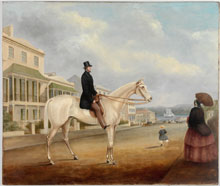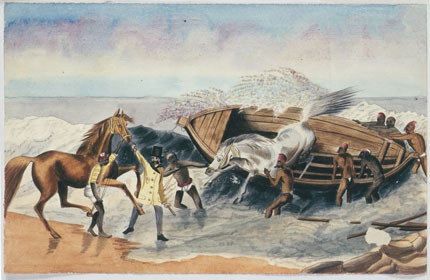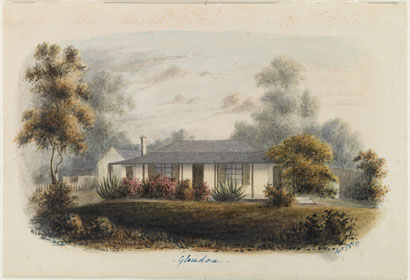Thoroughbreds and champions
Horse ownership has long been a symbol of status and thoroughbred horses quickly became the prized possessions of colonial officers, gentlemen and squatters.
Proof of this lies in the number of horse portraits commissioned from colonial artists by proud owners. Recorded for posterity, these rare images allow us to admire the beauty of legendary Australian racing champions and thoroughbreds.
Above left: Stephen Butts on a white horse, Macquarie Street, Sydney, c.1850, by Joseph Fowles. Oil painting DG 250
Above right: Captain Frederick John Butts and a fellow officer, Hyde Park Sydney, 1858, by Joseph Fowles. Oil painting DG 251
After the arrival of the seven First Fleet horses, colonists lost no time in improving the quality of their bloodstock by importing thoroughbreds from England and India. Horses bred in New South Wales were quickly dubbed 'Walers' and, gaining a reputation for their robust sturdiness and stamina, were soon being exported back to India for use by the British army.
Landing horses from Australia, c.1834, J. B. East attrib.
Watercolour DGSV*/Hors/1
> Read a first hand-account of transporting horses to Calcutta aboard the Henrietta in 1844
Horses played a major role in the pioneering of Australia and there was an urgent need for fast, sound mounts. English racing identity, Admiral Rous, became involved in colonial breeding while stationed in Sydney between 1827 and 1829, importing the stallions Emigrant and Theorem.
Many of the people who carved out pastoral empires in the colony also contributed to the making of the Australian horse, such as John Macarthur of Camden Park, D'arcy Wentworth - owner of Hector, Henry Kater of Bungarribee Stud, Robert and Helenus Scott of Glendon and the great breeding families of the Hunter Valley.
Glendon, 1837, by AER
Watercolour SSV1B/Sing D/1
Writing to the Colonial Secretary in 1834, Colonel Dumaresq declared that 'no part of the world is better adapted than this for the rearing of every description of horses'. As the 19th century progressed, a distinctively Australian breed emerged, heavier and with more stamina than the Arab or thoroughbred, but suitable for similar work. 'Bush thoroughbreds' also provided cattlemen with stockhorses, polo ponies and work horses.
Ownership of a thoroughbred horse in the 19th century can be equated to prestige car ownership today. Colonial businessmen, gentlemen of fashion, landowners and sportsmen, all sought to document the pedigrees of their prized horseflesh for breeding purposes, and often commissioned portraits from leading animal painters, such as Edward Winstanley and Joseph Fowles.








